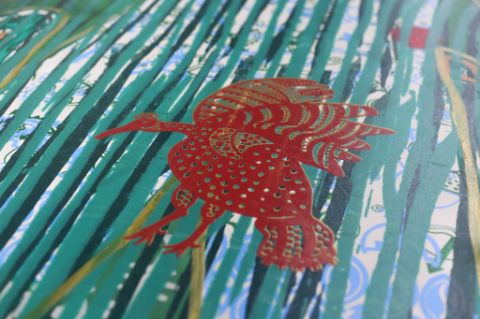Alberto Pitta

Work in progress. Photo: Jeferson Lima
Since the late 1970s, Alberto Pitta has been creating textiles that affirm and celebrate Afrodiasporic culture in Brazil. Created using a silk-screen printing technique, Pitta’s exuberant fabrics have contributed to the Afro-Bahian aesthetic that brings Carnival to life, incorporating embroidery motifs, spiritual symbols of the diasporic Candomblé religion, and documentary photography. His textiles often honour Afro-Bahian cultural practitioners, such as the artist and Candomblé priest Mestre Didi. From his studio in Bahia, Pitta designs the outfits and entire processions of the Afro blocks, the Afro-Bahian carnival associations that parade through the city avenues during the celebration. Pitta’s practice lies in the ‘stories that textiles can tell’—a medium to rescue, preserve, transmit, and enliven cultures, while also a means of self-affirmation and liberation against racism. For O Quilombismo, Pitta has created a series of canvases transforming the facade into a passage of visual storytelling. One side of the mural welcomes visitors into the world of Ogum, a Yoruba deity of Candomblé known for his path-opening qualities, who is celebrated by quilombist, anti-colonial communities to this day. The other side shows the communal housing of contemporary quilombos in Bahia standing with pride, announcing the stories to come of a HKW that re-opens as a Haus of many houses.
Commissioned by Haus der Kulturen der Welt (HKW), co-produced by Alberto Pitta and HKW, 2023.
Works in the exhibition: Ogum que são sete [Ogum who are seven] (2023); Moradismo: estéticas de quilombo [Moradismo: aesthetics of the quilombo] (2023), mural, 2 series of serigraphy on canvas, fourteen serigraphies, 345 x 300 cm each. Courtesy of the artist